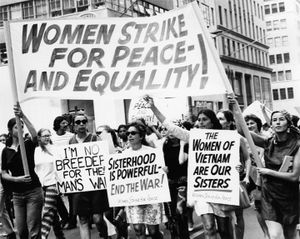Second-Wave Feminism from 1960-1980
Second-wave feminism' is a term that describes the feminist movement that began in the early 1960’s and developed more extensively into the 1980’s. This wave of feminism focused on equality rights and strove to challenge the social and gender norms that put women in weaker societal roles compared to men. Initially, goals revolved around employment inequality and disparities between men and women in the workplace. However, a radical approach to second-wave feminism was later developed that would focus on completely eliminating aspects of patriarchy that could negatively affect the overall quality of living for women.
History
During World War ll, as men were being shipped off to battle and demand for goods and services remained at increasing rates, women were entering the workforce more than ever during this deep societal and economic change. However, women’s roles remained traditional and tied to domestic responsibilities of the family and house. Employment was harder to find and harder to advance in due to the presumed idea that women would eventually become pregnant during work, or have to leave for other reasons related to child care and family. Few professional and employment opportunities were available and limited to jobs such as teachers, secretaries, or nurses. Issues that arose in the workplace involved sexual harassment, women’s severe limits on advancements and managerial jobs, and gender disparities in pay. Growing dissatisfactions between the treatment of men and the treatment of women began to lead feminism into challenging women’s supressed roles in society and re-make gender standards. This response was the onset of second-wave feminism and the following events that strove for values of equality in all aspects of being a woman.
Movements
The National Organization for Women (NOW)
In addition to the increasing female employment rates accumulated after World War ll, feminist influencers and leaders gained inspiration from the peak of Civil Rights Movement in the 1950s-1960s. This movement strove to secure basic privileges and rights and equal access to opportunities for African Americans, similar to the goals and efforts in feminist values at the time.
Mirroring the National Association for the Advancement of Colored People (NAACP), a women’s pressure group called the National Organization for Women (NOW) was established to address women’s rights issues. In 1964, after the establishment of the new Equal Employment Opportunity Commission failed to include laws that protected women workers, NOW was created in order to pressurize legislation and lobby for equality rights and fought against discrimination in the workplace. Concerns to maternity leave rights, providing child-care for mothers at work, tax deductions on child care expenses, equal access to education and job-training were essential measures the organization focused on. Now, the organization has expanded its efforts into eliminating all forms of discrimination, fighting intersectionality, strengthening feminist ideals, and achieving equality for women of every race and social class.
Women's Strike for Equality
On August 26, 1970, the 50th anniversary of women’s suffrage, 50,000 feminists marched down Fifth Avenue in New York City in a demonstration of women’s liberation and equality. It is often remembered as the largest protest at the time, with nationwide demonstrations taking place in over ninety cities across the United States. Leader of the National Organization for Women (NOW) which orchestrated the protest, Betty Friedan, headed the march in order to spread awareness on women’s rights issues and ask women to strike for equality. The march gave great visibility to the feminist movement, and showed immediate effects to NOW which grew by 50% in membership.
Civil Rights Act Amendments
Although focus on equality and opportunity were essential measures of second-wave feminism, issues of domestic violence and sexual harassment were also strongly addressed. The women’s traditional role in the home as a mother and housewife made them subject to greater chances of abuse at the hands of their husband, while occurrences of sexual harassment went unreported in male-dominating workplace environments. In 1968, the Equal Employment Opportunity Commission passed an amendment to the Civil Rights Act of 1964 which would protect workers from discrimination based on race, color, religion, sex or national origin. This was a huge success for the National Organization for Women (NOW) who lobbied for prohibition of workplace violence and sexual harassment.
Leadership
Betty Friedan
In 1962, writer and feminist, Betty Friedan released a book called The Feminine Mystique, which is often believed to have started the second wave of feminism. In her writing, Friedan describes experiences of despair and mistreatment as a college-educated housewife and calls for women’s servitude to move away from the responsibilities of the housewife, and instead towards the individual goals and freedoms that rest in the outside world. With incredible nation-wide response, her broadcasting of similar experiences in inequality and oppression allowed women around the world to unite among a common purpose. In its first three years of publication, Friedan had sold over three million copies, spreading new ideas and values of feminism like wildfire. This contributed greatly to the beginnings of second-wave feminism and credits Friedan as one of the most important feminist leaders of this period. She later become the first president of the National Organization for Women (NOW) in 1966.
References
Thompson, B. (2002). Multiracial Feminism: Recasting the Chronology of Second Wave Feminism. Feminist Studies, 28(2), 337-360. doi:10.2307/3178747
https://www.britannica.com/topic/womens-movement
https://opentextbc.ca/postconfederation/chapter/7-10-the-second-wave-of-feminism/
http://people.howstuffworks.com/femin
https://www.eeoc.gov/laws/statutes/titlevii.cfm

